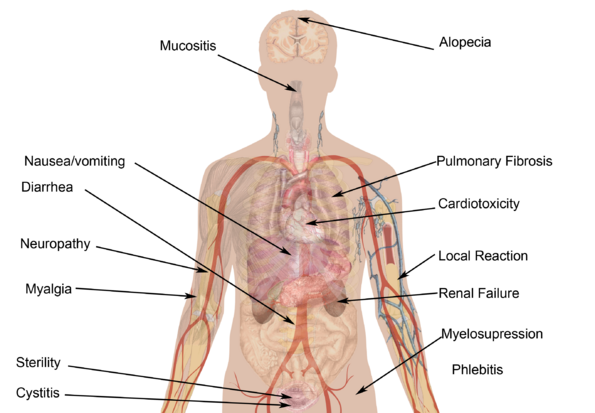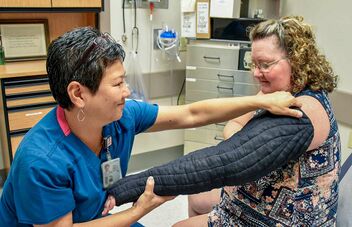Oncology Rehabilitiation
Original Editors Sehriban Ozmen and ReLAB-HS
Top Contributors - Sehriban Ozmen, Kim Jackson, Naomi O'Reilly, Ashmita Patrao, Rachael Lowe, Ewa Jaraczewska and Oyemi Sillo
Introduction[edit | edit source]
The Rehabilitation 2030 call to action, launched by the World Health Organization in 2017, aimed to advance global access to rehabilitation for non-communicable diseases.[1] In this context, the field of oncology was declared a priority, considering the acute and persistent effects of cancer. [2]
Oncology rehabilitation is an area that has the potential to reduce cancer-related morbidity and healthcare costs. [3]
Often used interchangeably with cancer rehabilitation, oncology rehabilitation focuses on managing and improving the impairments and functional limitations experienced by individuals with cancer due to the disease itself or the side effects of the treatment they receive. [4]
Indications[edit | edit source]
Some of the complications that can be addressed in oncology rehabilitation are listed below. [5]
- Pain
- Fatigue
- Chemotherapy-Induced Peripheral Neuropathy (CIPN)
- Spasticity [6]
- Cognitive deficits
- Psychosocial problems
- Sexual dysfunction
- Urinary dysfunction
- Speech impairment
- Swallowing impairment
- Chemotherapy Side Effects and Syndromes
- Symptoms of Lymphoedema
- Radiation Side Effects and Syndromes
- Paraneoplastic Syndrome
- Functional Limitations
Four Phases of Oncology Rehabilitation[edit | edit source]
According to the model developed by Dr. Dietz Jr. in 1980 [7], cancer rehabilitation includes four stages:
- Preventative rehabilitation phase: More recently called prehabilitation in cancer care, encompasses the time between the onset of cancer diagnosis and the beginning of oncological treatment. The interventions during this period include patient education and therapies that aim to decrease the impact of expected disability from oncological care. [6] It has been found by researchers that it is beneficial to undergo rehabilitation prior to beginning cancer treatment. [8]
- Restorative rehabilitation: It focuses on restoring the cured or controlled patients with residual impairments that cause disability to their previous level of function. [6]
- Supportive rehabilitation: This phase provides care to maximize functionality as individuals experience declines due to progressive or stable cancer. [6]
- Palliative phase: Although palliative care is not limited to the end of life, this model uses this term to emphasise the care aiming at comfort and function in the terminal stage of cancer. [6]
Settings For Oncology Rehabilitation[edit | edit source]
Understanding the context in which rehabilitation care is provided is crucial to ensure patients receive the most suitable treatment. Currently, rehabilitation services can be administered in various settings, including inpatient, outpatient, or at home. However, these services are generally classified into post-acute care and outpatient therapy: [6]
- Post-acute care: Includes inpatient rehabilitation facilities, skilled nursing facilities, home health care agencies, and long-term care hospitals. [6]
- Outpatient therapy: Involves patient visits at a therapy center for focused rehabilitation intervention. [6]
Assessment Tools[edit | edit source]
The outcome measures that used in studies to assess the patient's status after the treatment/interventions are listed below. [9]
- Health-related quality of life and/or quality of life: The European Organization for Research and Treatment of Cancer Quality of Life Questionnaire, the 36-Item Short Form Survey, and the Functional Assessment of Cancer Therapy.
- Activities of daily living and instrumental activities of daily living
- Fatigue
- Functional mobility
- Exercise behavior
- Cognition function: Neuropsychological tests, patient-reported outcome measures.
- Communication
- Sexual function
- Return to work
Also, you can visit the oncology examination page to see examination tools used for oncology rehabilitation.
Multidisciplinary Rehabilitation[edit | edit source]
Multidisciplinary outpatient cancer rehabilitation can improve a patient's physical and psychosocial status. [10]
The professions that can be included in the multidisciplinary oncology rehabilitation team are stated below, along with their functions.
Physiatrist[edit | edit source]
- Conducts diagnostic evaluations, including electromyography, functional assessments, musculoskeletal and neurological examinations, as well as imaging studies.
- Prescribes pain-relieving medications to treat nonmalignant conditions arising from cancer treatments.
- Performs peripheral joint, musculoskeletal, and interventional injections.
- Recommends assistive devices, such as splints and braces. [11]
Nurse[edit | edit source]
Physiotherapist[edit | edit source]
- Detects and plays an active role in the management of many cancer-related impairments such as pain and reduced range of motion or physical fitness which may prevent patients from performing daily activities and participation roles. They make it possible by teaching coping strategies, maximising compensation capacity, and improving the ergonomics of (alternative) movement strategies. Yet with their specialised knowledge and advanced skills, they can also support individuals with cancer in their specific needs such as lymphoedema, peripheral neuropathy, and cancer-related fatigue. [12]
- Prescribes exercise programme (which is acknowledged as a standard practice in cancer care recently[13]) to improve strength, cardiorespiratory fitness and quality of life as well as reducing fatigue and depression. [14]
- Uses beneficial modalities such as Massage Therapy, Transcutaneous Electrical Nerve Stimulation (TENS) and compression bandaging to alleviate the symptoms of patients with advanced cancer. [15]
As recommended by the National Cancer Policy Forum in the United States; the integration of physiotherapy into cancer care in order to reduce long-term, treatment-related adverse effects and disability should start ideally at the point of cancer diagnosis.[16]
Occupational Therapist[edit | edit source]
Speech and language therapist[edit | edit source]
Dietitian/Nutritionist[edit | edit source]
Orthotist[edit | edit source]
Prosthetist[edit | edit source]
Mental Health Counselor[edit | edit source]
Exercise Physiologist[edit | edit source]
Music Therapist[edit | edit source]
- Performs assessments to detect the strengths and needs of patients and their families. These assessments include various domains, including emotional status, coping mechanisms, mental health, and symptom distress. [17]
- By applying music therapy, they can help ensure personalized, comprehensive care and efficient use of often-limited psychosocial care resources. [18]
Resources[edit | edit source]
- Oncology Medical Management
- Immunotherapy
- Oncology Physiotherapy Management
- Physiotherapy Role in Geriatric Oncology
- Physiotherapy in Palliative Care
- Cancer Rehabilitation and the Importance of Balance Training
- The Role of the Physiotherapist in Palliative Care for People With Lymphoedema
- Physical Activity in Cancer
- Telehealth in Oncology: ASCO Standards and Practice Recommendations
References [edit | edit source]
- ↑ World Health Organization. Global action plan on physical activity 2018-2030: more active people for a healthier world. World Health Organization; 2019 Jan 21.
- ↑ Gimigliano F, Negrini S. The World Health Organization" rehabilitation 2030: a call for action". European Journal of Physical and Rehabilitation Medicine. 2017;53(2):155-68.
- ↑ Smith SR, Zheng JY, Silver J, Haig AJ, Cheville A. Cancer rehabilitation as an essential component of quality care and survivorship from an international perspective. Disability and rehabilitation. 2020 Jan 2;42(1):8-13.
- ↑ Cheville A, Smith S, Barksdale T, Asher A. Cancer rehabilitation. Braddom's Physical Medicine and Rehabilitation. 2021 Jan 1:568-93.
- ↑ Sleight A, Gerber LH, Marshall TF, Livinski A, Alfano CM, Harrington S, Flores AM, Virani A, Hu X, Mitchell SA, Varedi M. Systematic review of functional outcomes in cancer rehabilitation. Archives of physical medicine and rehabilitation. 2022 Sep 1;103(9):1807-26.
- ↑ 6.0 6.1 6.2 6.3 6.4 6.5 6.6 6.7 6.8 Raj VS, Pugh TM, Yaguda SI, Mitchell CH, Mullan SS, Garces NS. The who, what, why, when, where, and how of team-based interdisciplinary cancer rehabilitation. InSeminars in oncology nursing 2020 Feb 1 (Vol. 36, No. 1, p. 150974). WB Saunders.
- ↑ Broadwell DC. Rehabilitation needs of the patient with cancer. Cancer. 1987 Aug 1;60(S3):563-8.
- ↑ Brennan L, Sheill G, O’Neill L, O’Connor L, Smyth E, Guinan E. Physical therapists in oncology settings: experiences in delivering cancer rehabilitation services, barriers to care, and service development needs. Physical therapy. 2022 Mar 1;102(3):pzab287.
- ↑ Sleight A, Gerber LH, Marshall TF, Livinski A, Alfano CM, Harrington S, Flores AM, Virani A, Hu X, Mitchell SA, Varedi M. Systematic review of functional outcomes in cancer rehabilitation. Archives of physical medicine and rehabilitation. 2022 Sep 1;103(9):1807-26.
- ↑ Kudre D, Chen Z, Richard A, Cabaset S, Dehler A, Schmid M, Rohrmann S. Multidisciplinary outpatient Cancer rehabilitation can improve Cancer patients’ physical and psychosocial status—a systematic review. Current oncology reports. 2020 Dec;22:1-7.
- ↑ Silver JK, Baima J, Mayer RS. Impairment‐driven cancer rehabilitation: an essential component of quality care and survivorship. CA: a cancer journal for clinicians. 2013 Sep;63(5):295-317.
- ↑ Stuiver MM, Stout NL, Dennett AM, Speksnijder CM, Campbell KL. An international perspective on integrating physiotherapists in oncology care. Journal of physiotherapy. 2019 Oct 1;65(4):186-8.
- ↑ Cormie P, Atkinson M, Bucci L, Cust A, Eakin E, Hayes S, McCarthy AL, Murnane A, Patchell S, Adams D. Clinical Oncology Society of Australia position statement on exercise in cancer care. Medical Journal of Australia. 2018 Aug;209(4):184-7.
- ↑ Dennett AM, Sarkies M, Shields N, Peiris CL, Williams C, Taylor NF. Multidisciplinary, exercise-based oncology rehabilitation programs improve patient outcomes but their effects on healthcare service-level outcomes remain uncertain: a systematic review. Journal of Physiotherapy. 2021 Jan 1;67(1):12-26.
- ↑ Vira P, Samuel SR, Amaravadi SK, Saxena PP, Rai PV S, Kurian JR, Gururaj R. Role of physiotherapy in hospice care of patients with advanced cancer: a systematic review. American Journal of Hospice and Palliative Medicine®. 2021 May;38(5):503-11.
- ↑ National Academies of Sciences, Engineering, and Medicine. Long-term survivorship care after cancer treatment: Proceedings of a workshop. National Academies Press; 2018 Jul 9.
- ↑ Wentworth TA. What We Do and Who We Are: The Role of Music Therapy Scope of Practice and Scope of Competence in the Development of Professional Identity (Doctoral dissertation, Ohio University).
- ↑ Knott D, Krater C, MacLean J, Robertson K, Stegenga K, Robb SL. Music Therapy for children with oncology & hematological conditions and their families: advancing the standards of psychosocial care. Journal of Pediatric Hematology/Oncology Nursing. 2022 Jan;39(1):49-59.








